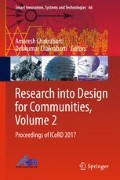Abstract
The paper proposes to change the way to improve a product by switching the DfD approach (Design for Disassembly) into DfR (Disassembly for Redesign). The concept is to disassemble a product by keeping the just necessary parts that achieve the basic service, the product being still in operation. The disassembly procedure (tasks, tools, duration, resulting parts, …) is recorded in order to express how much frugal the product is. The frugality index measures the difference between the product before and after the disassembly procedure, it consequently expresses the energy to spend to innovate in a more responsible way. The methodology is supported by an example on an EEE product. A discussion is finally engaged to present the limits and the perspectives of the approach.
Access this chapter
Tax calculation will be finalised at checkout
Purchases are for personal use only
References
Kuo, T.-C., Huang, S.H., Zhang, H.-C.: Design for manufacture and design for ‘X’: concepts, applications, and perspectives. J. Comput. Ind. Eng. 41, 241–260 (2001)
Lehto, J., Harkonen, J., Haapasalo, H., Belt, P., Mottonen, M., Kuja, P.: Benefits of DfX in requirements engineering. J. Technol. Investment 2, 23–27 (2011)
Ilgin, M.A., Gupta, S.M.: Environmentally conscious manufacturing and product recovery (ECMPRO): a review of the state of the art. J. Environ. Manage. 91, 563–591 (2010)
Mital, A., Desai, A., Subramanian, A., Mital, A.: Designing for assembly and disassembly. In: Product Development, 2nd edn., pp. 159–202. Elsevier, Aamsterdam (2014)
Rios, F.C., Chong, W.K., Grau, D.: Design for disassembly and destruction—challenges and opportunities. Procedia Eng. 118, 1296–1304 (2015)
Sabaghi, M., Mascle, C., Baptiste, P.: Evaluation of products at design phase for an efficient disassembly at end-of-life. J. Clean. Prod. 116, 177–186 (2016)
Gries, B., Blessing, L.: Towards a disassembly process oriented design of sustainable products. In: 14th International Conference on Engineering Design (2003)
Kljajin, M., Opalic, M.: Product disassembly sequences approach in the early stage of product design. In: 8th International Design Conference (2004)
Iacob, R., Poposecu, D., Mitrouchev, P.: Assembly/disassembly analysis and modeling techniques: a review. J. Eng. 11, 653–664 (2012)
Soh, S.L., Ong, S.K., Nee, A.Y.C.: Application of design for disassembly from remanufacturing perspective. In: 12th Global Conference on Sustainable Manufacturing, pp. 577–582 (2015)
Bhatti, Y., Khilji, S.E., Basu, R.: Globalization, change and learning in South Asia. In: Chandos Asian Studies Series, pp. 123–145. Woodhead Publishing Limited, Cambridge (2013)
Rosca, E., Arnold, M., Bendul, J.C.: Business models for sustainable innovation—an empirical analysis of frugal products and services. J. Cleaner Prod. (2016) (in press, available online)
Rao, B.C.: How disruptive is frugal ? J. Technol. Soc. 35(1), 65–73 (2013)
Jeandin, T., Mascle, C.: A new model to select fasteners in design for disassembly. In: 13th Global Conference on Sustainable Manufacturing, pp. 425–430 (2016)
Eriksen, K.A.: New demands on design for disassembly to improve recycling of electrical and electronical products. In: 7th NordDesign Conference (2008)
Bovea, M.D., Pérez-Belis, V., Ibáñez-Forés, V., Quemades-Beltrán, P.: Disassembly properties and material characterisation of household small waste electric and electronic equipment. J. Waste Manag. (2016) (in Press, Available online)
Zuidwijk, R., Krikke, H.: Strategic response to EEE returns: product eco-design or new recovery processes? Eur. J. Oper. Res. 191(3), 1206–1222 (2008)
Author information
Authors and Affiliations
Corresponding author
Editor information
Editors and Affiliations
Rights and permissions
Copyright information
© 2017 Springer Nature Singapore Pte Ltd.
About this paper
Cite this paper
Rohmer, S., Rodriguez, P. (2017). Disassembly for Redesign. In: Chakrabarti, A., Chakrabarti, D. (eds) Research into Design for Communities, Volume 2. ICoRD 2017. Smart Innovation, Systems and Technologies, vol 66. Springer, Singapore. https://doi.org/10.1007/978-981-10-3521-0_33
Download citation
DOI: https://doi.org/10.1007/978-981-10-3521-0_33
Published:
Publisher Name: Springer, Singapore
Print ISBN: 978-981-10-3520-3
Online ISBN: 978-981-10-3521-0
eBook Packages: EngineeringEngineering (R0)

